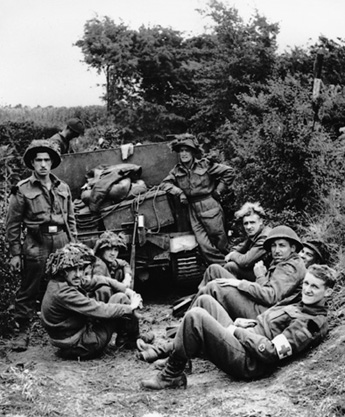
FIGHTING INDEPENDENTLY with exposed flanks and neither artillery nor tank support was common coin to the paratroops of 1st Canadian Parachute Battalion. They and the other battalions that comprised 6th British Airborne Division had managed to achieve every important D-Day mission assigned to them, and on June 7 set to consolidating the positions won. While some Canadian paratroops still wandered lost or purposefully navigated through no man’s land to reach the battalion’s objectives, most were engaged in setting up a strong defensive position astride the vital le Mesnil crossroads. Another smaller group remained dug in at the village of Robehomme, which overlooked a bridge crossing the River Dives that the para-troops had blown on D-Day. The force here, under command of Captain Peter Griffin, numbered about one hundred. But only thirty to forty men—mostly from ‘B’ Company—were Canadian. Lost British paratroopers, drawn towards Robehomme by the sounds of gunfire as Griffin’s men had fended off several determined German counterattacks on June 6, made up the rest.1
From the bell tower of Robehomme’s small church, Griffin watched German infantry slowly tighten a noose around his position throughout the daylight hours of June 7. Three miles separated Robe-homme and le Mesnil crossroads, with the town of Bavent situated at roughly the midway point. From his vantage, Griffin could see German troops gathered around Bavent, which stood astride the road they needed to take to get through to the battalion. A stretch of low country almost a mile wide had been flooded between Robehomme and Bavent when the Germans had breached the banks of the River Dives as a defensive measure, intended to prevent these open fields’ use as airborne drop zones. The raised roadbed connecting the two communities via Bricqueville provided the only viable route across the flooded ground. Griffin was under no illusions that his para-troopers could hold Robehomme indefinitely. They were surrounded and would eventually be outgunned and outnumbered. It would be wise to be gone from the village before the Germans decided they were strong enough to overrun the position.
Hoping that the Germans at Bavent might still be disorganized, Griffin and Lieutenant Norm Toseland decided to try slipping a patrol through to le Mesnil. Private W.J. Brady was one of the men sent on this mission. They returned soon enough, having determined that the Germans had established a roadblock to prevent such an attempt. With water covering the ground on either side of the road, there was no way the blocking position could be outflanked, even in darkness.2The Canadians had learned during the night of June 5–6 the perils of trying to slosh about in the flooded zones. Some men had drowned in water that was over their heads, while others had become hopelessly mired in deep mud, and it was virtually impossible to move quietly enough to avoid detection, anyway. There seemed no alternative. Griffin’s small force would just have to stay put. The paratroops were determined to protract the siege as long as possible, exacting a stiff price for their inevitable elimination.
AT THE CROSSROADS, Lieutenant Colonel G.F.P. Bradbrooke had problems of his own. The aloof commander of the parachute battalion, who had proven before the invasion to be more concerned with fussy administrative paperwork than preparing the men for combat, had gathered about four hundred Canadian paratroops around him by the morning of June 7. He had also surprised some of his officers and men during the long day’s fighting on D-Day by leading them with steely resolve on a bitterly contested march from the drop zone to the crossroads. There had been those who had thought Bradbrooke would prove a poor combat officer, but his performance that day indicated otherwise.
Most of the men at the crossroads were armed with rifles or Sten guns. Only a few had Bren guns. Ammunition and grenades were in short supply. During the dispersed drop, the containers holding the heavier weapons had by and large gone astray. Those that were found had usually broken open and the equipment inside was either wrecked or damaged. The mortar platoon had lost its mortars this way, and the majority of the battalion’s wireless sets had similarly been scattered to the winds or broken. Equipment lost in the drop tallied up to 50 per cent of the battalion’s total.3
The crossroads formed the intersection point for five roads that ascended the ridge’s gradually rising slopes from opposite compass points. Bavent ridge was only a significant feature because the country surrounding it was so low and flat. Running along a generally north-south line from Sallenelles near the coast almost to Troarn, which was east of and parallel to Caen, it formed the only viable defensive ground that the airborne division could use to advantage in securing its eastern flank. If the counterattacking Germans broke through the defensive line holding the ridge, they would likely succeed in pushing the division’s lines back to the River Orne bridges. These bridges, captured by British glider troops on D-Day, were vital to Second British Army’s plan to break out from the Normandy bridgehead and advance towards Paris.
Holding the ridge from Sallenelles to Bréville was the 1st Special Service Brigade, a commando force that had landed at Sword Beach and linked up with the airborne troops late on June 6. From Bréville, which stood atop the highest point, to where the ridge overlooked the southern extremity of a small forest known as the Bois de Bavent was the responsibility of 6th Division’s 3rd Brigade. The 9th Parachute Battalion held the line from right of Bréville to just short of the crossroads, then the Canadians took over the defence from the crossroads to the forest’s northern edge, where they handed off to the 8th Parachute Battalion.
The crossroads was easily identifiable on the ridge’s skyline because rising above it was the smokestack of a nearby brick and pottery plant. Bradbrooke had been quick to establish his headquarters inside the building, whose stout walls provided good protection against the German artillery and mortar firing that was directed against the paratroopers with ever increasing intensity as June 7 wore on. A short distance to the right of the crossroads, Brigadier James Hill put his headquarters in a small château and the 224 Field Ambulance’s aid post set up on the same property. Each of the 3rd Brigade’s battalions was responsible for about a mile of line that numbers would not allow to be held by positioning men along its entire length.4 Instead, Bradbrooke organized small strongpoints, with the strongest in front of the crossroads, and covered the flank positions with Vickers machine guns. These weapons had arrived mid-morning, having been landed at Sword and moved up to the battalion by jeep. A good stock of ammunition and a trio of mortars were also included in the resupply package. Happy to be back in business, the mortar crews established a firing position beside the brick factory from which they could bombard targets to the front of any point on the Canadian line.5
In addition to the vital supplies, Bradbrooke also received the cheering news that the battalion would be able to call on the British cruiser Arethusa and a destroyer for naval gun support. These two ships had been allotted specifically to fire missions assigned by 3rd Brigade, which was also given the dedicated support of the 302nd Field Battery of one of the 3rd British Infantry Division’s artillery regiments.6 The paratroops would not have to rely entirely on their own combat resources, after all.
The arrival of the mortars proved in the nick of time, for no sooner had they been dug into firing pits than a strong force of infantry supported by several self-propelled guns and Mark IV tanks struck the Canadian line. These were troops of the 346th Grenadier Division’s 857th and 858th regiments. The 346th had just arrived in the area after marching through the day and night from Le Havre, the only division to be released from the Pas de Calais on June 6 to meet the Allied invasion in Normandy.7 On D-Day, the Canadian paratroops had fought elements of the 716th Infantry Division. A coastal defence unit, the 716th had been comprised of soldiers generally considered unfit for service in active combat divisions. With its fighting teeth concentrated in bunkers directed towards the beach areas, the division had been ill-positioned to offer a coordinated defence against 6th Airborne Division’s drop and was shredded by day’s end. Brigadier Hill, however, reported that the 346th “was a first class German division,” so the Canadians faced a tough, competent adversary.8
German infantry came out of the woods west of the Canadians and headed across the open ground. The paratroops cut into them with a deluge of small-arms fire that dropped several dozen of the grenadiers, but the rest charged doggedly onward. When they closed to within a hundred yards, ‘B’ Company fixed bayonets and rushed out to meet the enemy rather than being overrun in their holes. Stunned by the ferocity of this charge, the grenadiers took to their heels and several were taken prisoner. One of the captured soldiers warned that the “Germans were desperate to capture the brickyard and the crossroads.” Having had the wind knocked out of them, however, the grenadiers opted against launching a second attack in favour of sniping at the Canadian lines and harassing them with mortar and artillery fire.9
The sudden appearance of the 346th Division on his front left Bradbrooke with two quandaries. First, there was obviously now a large, determined German force between the crossroads and Robe-homme, where Captain Griffin and the hundred paratroops with him were besieged. The lieutenant colonel was anxious to find a way to extract those men before they were overrun. Second, the Germans were obviously well endowed with armoured support—something he totally lacked. Leaving the German commander free to attack the Canadian front at will guaranteed that the combined tank and infantry forces would eventually penetrate the line and possibly overwhelm his men.
Bradbrooke decided the solution to both his problems was to be found in aggressive patrolling. While sending fighting patrols towards Bavent to throw the Germans off balance and perhaps force them to assume a defensive posture, he would also send a small patrol through the Bois de Bavent to find an unblocked route to Robehomme that could be used to guide that unit home.
Lieutenant Bob Mitchell, who commanded ‘A’ Company’s No. 2 Platoon, drew the job of trying to get through to Robehomme. Knowing he could only succeed by remaining undetected, the lieutenant decided to take just three men along. Private Ray Newman, who had proven his worth the night before as a scout for Mitchell, walked point.10 The other two men were selected more for their language skills than fieldcraft. Private E. Schroeder spoke fluent German, while Private L.S. Jones was equally adept at French.11
In the early afternoon, Mitchell and his three men crept past the front lines towards the woods. Newman thought it a shame to be going on such a mission with an empty stomach, but there had been no alternative. No rations had come up with the ammunition and heavy weapons, so food was in desperately short supply. Of course, when the paratroops were in action they would always take bullets over food. Death by starvation was not as likely as being killed by the enemy.
It was still light when Newman spotted “a character skulking along the edge of the Bois de Bavent. He was wearing a black beret, a civilian coat and airforce blue pants. He didn’t fool us for a minute. We lined him up in our sights and ordered him to advance. Sure enough, he turned out to be a Canadian Typhoon pilot who had been shot down on D-Day and who was now very relieved. We explained to him how to behave in the kind of territory we were in, and sent him on his way to le Mesnil.”
The patrol pushed into the woods on a circuitous three-mile trek Mitchell had mapped out as the most likely route for reaching Robehomme undetected. Out on point, Newman kept expecting to sight enemy soldiers at any moment, or at least French civilians. But the forest remained eerily devoid of life. They had been briefed that Robehomme was surrounded, yet the four men passed through the woods without incident. Even more to Newman’s surprise, they were then able to move up a soggy lane running through flooded pastures and fields to where it intersected the road running from Bricqueville to Bavent. It was now dark, and the Germans covering the road from a position east of Bavent failed to notice the patrol as it struck off on the raised roadbed running through the flooded ground that ended just short of Bricqueville. Skirting this settlement, which seemed deserted, Newman led the patrol into Robehomme by moving off to one side of a small road. That they made it through struck Newman as being nothing short of “miraculous.”12
Of the forty or so Canadians at Robehomme, thirty-five hailed from ‘B’ Company, while only a handful of the British paratroops were from the same unit. This meant the Canadians had the most cohesion as a fighting force, so Griffin decided they would lead the way out, with Mitchell’s little patrol on point as guides. Those wounded soldiers unable to walk were either put into a car volunteered by Robe-homme’s priest or a horse-drawn wagon provided by a local farmer. At 2330 hours, the entire force filed quietly out of Robehomme and headed into the darkness. Several times, the car, wagon, or both bogged down in mud, requiring a lot of pushing and pulling by the men on foot to wrest the stuck conveyance free.
Just past Bricqueville, a German sentry barked a challenge. The men at the head of the column immediately rushed the position, firing as they did so. In a matter of seconds, they killed seven of the eight Germans maintaining a guard post and captured the other. A few minutes later, “an automobile with headlights dimmed down to… narrow slits, and which therefore appeared ghostly, was perceived sliding along the Bavent road towards the column. When it was quite close it met a fierce volley of well aimed fire from our column,” the battalion’s war diarist later wrote. “It careened into a ditch and upon examination was found to contain the dead bodies of four German officers. The way was now clear to get on through the Bavent forest.” At 0330 hours, the column reached le Mesnil crossroads. The Canadians were quickly integrated back into their units, which greatly bolstered the fighting strength of ‘B’ Company, and the British troops headed off to return to their various units.13
While Mitchell’s patrol was engaged in rescuing Griffin’s force, Bradbrooke had also sent out three ‘C’ Company patrols over the course of the day towards Bavent. Although the first patrol was to use stealth to reach the village, avoiding enemy contact was not in the plan. Rather, Sergeant Harvey Morgan was going to attack Bavent with six men, while Corporal Dan Hartigan and Private Colin “Wild Bill” Morrison of Innisfail, Alberta covered them from a low rise to the right of the village. For this job, Hartigan was packing his two-inch mortar, a rifle, two bandoliers of rifle ammunition, all the mortar rounds he could scrounge, several grenades, and a Gammon bomb.14 The latter weapon, formally known as a Type 82 grenade, was a canvas bag stuffed with two pounds of plastic explosives fitted with a tumbler fuse covered by a plastic cap. Removing the cap exposed a detonator atop the fuse, which, when subjected to the slightest motion or impact, exploded the charge. The weapon had been invented by British paratrooper Lieutenant Jock Gammon to give airborne troops an ability to fight tanks without having to carry heavy conventional antitank mines.15 Morrison, “a huge raw-boned farm lad of twenty-one,” was equally heavily loaded down with bandoliers of magazines for his Bren gun.
The purpose of this nine-man attack on Bavent was “to make the enemy fire as many of their weapons as possible, and so give the Canadians an estimate of their strength in the village.” During the pre-patrol briefing, Morgan had calmly told the men that while Hartigan and Morrison covered them, he and privates Gilbert Comeau, Bill Chaddock, Clifford Douglas, M.M. “Pop” Clark, Eddie Mallon, and Jack Church would charge up the main street until Morgan yelled, “Take up positions!” Then all but Morgan and Chaddock would take cover and start sniping at anything that moved. Morgan and Chaddock, meanwhile, would attack the nearest two-storey building—nobody cared which one—and sweep it clear in a standard enter and search manoeuvre in order to wipe out any snipers or machine-guns positioned in the upper storey or on the roof. It was expected that the audacity of this action would badly shake the Germans in the village and weaken their resolve to tackle the obviously fighting mad Canadian paratroops.
With superb training in fieldcraft, the patrol managed to gain the edge of Bavent without being detected. Hartigan and Morrison scrambled into their position just in time to get set up, as Morgan led the other men in the charge. As the men dashed up the street, they were met by heavy small-arms fire from the other end of the village. With Hartigan popping smoke rounds into the street to cover the running Canadians, Morrison started burning off one Bren magazine after another at the many live targets revealing themselves. Despite the covering smoke, a machine-gun burst stitched across Comeau’s chest and he dropped dead on the cobblestones seconds before Morgan shouted, “Take up positions.”
The sergeant and Chaddock burst through the entrance door of a house as per procedure almost side by side. One swept “the first room to the left, the other to the right, where they killed two German soldiers. Then, after exploding a hand grenade on the space above the hall stairway, up they went and cleared the upper floor. They did a rapid search and, within seconds, Morgan led Chaddock to another building, tossing grenades in as chunks of concrete and brick flew everywhere from enemy machine-gun fire. The bullets sprayed nearby as they stepped aside to let their lobbed-in grenades explode. Another standard-drill entry brought them face to face with a big German sergeant. He and Morgan must have fired at the same instant, for the German fell to the floor and Morgan was wounded. He had two Schmeisser rounds in his abdomen.”
Hartigan and Morrison covered the fighting party’s rapid retreat from the village, with the corporal throwing down a mix of smoke for cover and shrapnel bombs to keep the Germans ducking. The whole raid was concluded in minutes, and then the patrol scrambled back to the crossroads under heavy protective fire laid down by the men in the front lines. When Morgan “came tumbling over a low stone wall, which had marked our jumping off point to begin with,” Hartigan noticed that “he was clasping his bleeding abdomen.” The sergeant gave a terse report to ‘C’ Company’s Lieutenant Sam McGowan and then, rejecting offers of assistance, walked straight to 224 Field Ambulance’s surgery for treatment.16
Even as the patrol had scampered out of the southeastern corner of the village, the troops had noticed the Germans were also on the run—pulling back into Bavent’s northwestern quadrant. A three-man follow-up patrol a couple of hours later, which managed to capture a slightly damaged German mortar on a rise overlooking the
Canadian troops take a break in the shelter of a hedgerow during the march inland on June 7. R. Bell, LAC PA–140849.
The 29th Canadian MTB Flotilla (right) passes a convoy en route to its patrol area on June 7. Note the barrage balloons hovering over the convoy ships. Gilbert Alexander Milne, LAC PA–144576.
Infantry dig into open field on June 8. In the far distance, a squadron of Sherman tanks provides a defensive screen. R. Bell, LAC PA–131442.
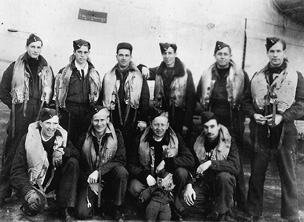
This photo of Flying Officer Kenneth Moore and his crew was taken immediately after their return from the June 7–8 mission during which they sank two U-boats. Back row, left to right: Don Griese, Jack Hamer, Ernie Davidson, co-pilot (first name unknown) Catcheson, Alec Webb, J. “Scotty” McDowell. Front row, left to right: navigator Alex Gibb, Mike Werbiski, K.O. Moore, Dinty, Bill Foster. Courtesy of Kenneth Moore.
Paratroopers of 1st Canadian Parachute Battalion dug in behind a hedgerow at le Mesnil crossroads on June 8. D.A. Reynolds, LAC PA–130154.
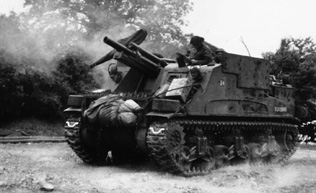
A 13th Field Regiment, RCAPriest self-propelled gun in action near Bray. Frank L. Dubervill, LAC PA–114577.
General Bernard Law Montgomery gives a press briefing shortly after coming ashore in Normandy to oversee the push in from the beaches. R. Bell, LAC PA–132475.
Personnel of Le Régiment de la Chaudière manning a front-line position near Colomby-sur-Thaon on June 9. R. Bell, LAC PA–129043.
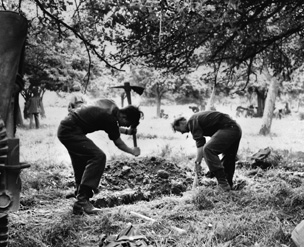
Men of the 9th Canadian Infantry Brigade digging a slit trench in an orchard on June 9. Picks and shovels were favoured over short-handled and small entrenching tools originally issued for this task. R. Bell, LAC PA–133955.
Men from the Regina Rifles support company man a three-inch mortar just outside Bretteville-l’Orgueilleuse. Front, left to right: Riflemen D.E. “Dan” Corturient, A.V. “Swede” Renwick, W.R. “Win” Powell. Background: Rifleman George Cooper, Sergeant Tom Holt, Rifleman Ben Wilson. Donald I. Grant, LAC PA–128794.
Private R.L. Randolf of the Canadian Scottish Regiment in his slit trench in front of Putot-en-Bessin with two-inch mortar at the ready. Note the use of branches for camouflage. Donald I. Grant, LAC PA–131431.
Canadian troops welcomed by French civilians as they liberate an unidentified village on June 10. Donald I. Grant, LAC PA–137978.
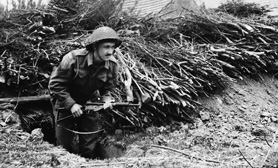
Canadian soldier armed with a Sten gun stands guard inland from Juno Beach on June 9. R. Bell, LAC PA–132802.
Men from Regina Rifles ‘D’ Company using a hole in the wall surrounding la Ferme de Cardonville as an observation point for monitoring German movement. Donald I. Grant, LAC PA–129042.
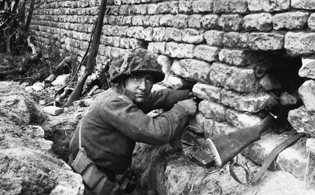
Regina Rifles ‘D’ Company soldier at a loophole cut into the wall at la Ferme de Cardonville. Donald I. Grant, LAC PA–131423.
Panther tank that Rifleman Joe Lapointe knocked out in Bretteville on the night of June 8–9 with a PIAT gun. Frank L. Dubervill, LAC PA–130149.
Canadian tanks in distance engage advancing German infantry on June 9, a battle that appeared to little disturb the cow in the foreground. R. Bell, LAC PA–137444.
Private Alvin Guitar and Gunner W.M. Holmes guard Hitler Youth prisoners that were rounded up by Le Régiment de la Chaudière on June 12. Frank L. Dubervill, LAC PA–133958.
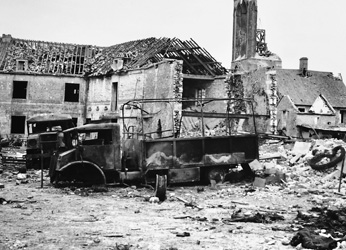
The aftermath of battle in Bretteville. Building in foreground was Regina Rifles battalion headquarters. Behind, the ruins of the cathedral. Frank L. Dubervill, LAC PA–133735.
During a brief lull in the fighting, a group of Canadians improvise a meal with compo rations and some fresh farm eggs. Left to right: Lance Corporal W.T. Haggerty, Lance Corporal B.J. Doucette, Corporal A. Boudreau, Company Sergeant Major R.M. Cooper. In the background is Lance Corporal Tellum. R. Bell, LAC PA–142037.
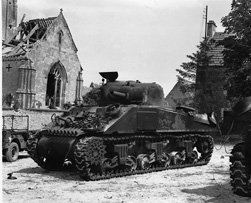
One of the Fort Garry Horse tanks knocked out in Rots. In the background stands the village’s badly damaged church. Frank L. Dubervill, LAC PA–169307.
Temporary cemetery established outside Bernières-sur-Mer by 8th Canadian Infantry Brigade for its soldiers killed during the fighting of June 6–12. Frank L. Dubervill, LAC PA–133753.
Sherman tank at the back of a column moving inland from Juno Beach on June 8, its turret reversed to guard the rear. The French tricolour it is flying serves as a recognition signal. Donald I. Grant, LAC PA–131424.
village and bombarded the enemy until all the munitions were expended, observed that the troops in Bavent had not yet reoccupied the abandoned area. Nor did they venture out to try and silence the mortar harassing them.
Hartigan noticed how this report substantially bolstered ‘C’ Company’s morale. “They now knew their enemies were, like themselves, subject to human frailty. They [Morgan’s platoon] had done it all, and the enemy though well armed and in good positions, had managed to kill only one of them… Knowing that they could shake up a much larger body of enemy soldiers boosted their confidence. Even so, everyone was happy to be well out of it and figured it would be some time before they’d have to do something as crack-brained again. Nine men with light but well-organized support from a firm firebase had assaulted a considerably greater enemy force, killed four to six of them and wounded others, and got away with it.”17
But ‘C’ Company’s patrolling work for June 7 was not yet over. To the amazement of all the section leaders, they were summoned to the company headquarters in an old house next to the crossroads and briefed by their commander, Major John Hanson, on another daylight mission towards Bavent that would be followed up by a patrol after dark. The sections of Sergeant Dick MacLean and Sergeant M.C. “Mosher” MacPhee would carry out both operations, while Morgan’s section, now led by Hartigan, would be responsible for ‘C’ Company’s defensive positions at the crossroads. The daylight task entailed escorting two Royal Engineers and a couple of British artillery Forward Observation Officers to where the earlier patrol had captured the mortar. From this height, the artillerymen would direct fire by the 302nd Field Battery on enemy targets, while the engineers plotted a route by which the night patrol could enter Bavent from the north. The purpose of this penetration was to plant booby traps and antipersonnel mines around an enemy vehicle park.
When Sergeant Dick MacLean briefed his men on the task, privates H.B. “Sinkor” Swim and Willard Minard looked at each other in consternation—realizing that this patrol and the night one would be using exactly the same route to approach Bavent as Morgan’s fighting patrol had earlier traversed. The two privates muttered to each other that “taking the same route… was certain suicide.”18 Surely the Germans would twig to how the Canadians were getting into their front yard—much of which followed a tree-shadowed bank of le Prieur irrigation canal. All they had to do was set up a machine gun at their end of the canal and fire down its length to slaughter the advancing patrol.
Despite thinking the mission the height of lunacy, the fourteen paratroops walked out into the afternoon sun with their four charges in tow. A sharp breeze was blowing as they moved through several apple orchards and then ventured out on the narrow track that bordered the canal. The overhead branches rustled loudly, while the tall grass growing up around the trees shivered as if Germans were crawling around there. MacLean and Swim were on point, one watching forward and left and the other forward and right, while also furtively scanning the overhanging branches for enemy snipers. Finally, they reached a canal crossing, slipped over it, gained the rise, and hunkered down while the engineers discussed viable approaches for the night mission and the two artillery officers looked down upon an amazing target.
In a meadow beside Bavent, a large group of German soldiers had dug a series of slit trenches to form a fighting position and were now lying around on the grass enjoying the breeze and warm sunshine. One of the artillerymen spoke into the handset of the No. 18 wireless he carried. Soon a shell exploded to the east of the Germans. The FOO radioed a correction that brought a shell down this time west of the enemy. Both having landed well away from their position, neither round alerted the Germans to the closing threat, which struck a few minutes later when the artillery battery dropped a full concentration directly onto them. Although Swim knew the men below were the enemy, he found it “agonizing to watch their awful fate.” When the smoke cleared, “dead bodies [lay] everywhere as the living squirmed along the ground, trying to reach their slit trenches.”19
By 1530 hours, the patrol had returned unscathed to le Mesnil crossroads and the men were told to bed down in Hanson’s house to get some rest before going out on the night patrol. It was the first sleep any of the men had managed since a dawn reveille on June 5 at Harwell Field in England. Yet the majority of the soldiers, including Swim, found rest elusive. After the early morning raid on Bavent and the shelling of the soldiers—obviously brought down on them by someone directing fire from nearby—the Germans would surely be lying in wait.
When one of the men began muttering darkly to the others that they should refuse the night mission, Swim slammed him against a wall, shouted into his face, and shook him roughly. But the soldier was undeterred, so Swim reported the man to MacLean, who in turn took the matter to Major Hanson. The major, a big, blustery, raw-boned man, called the entire section out of the house and lined them up. He dressed them all down, as if every one of them was attempting to shirk his duty. Then he grabbed the shirker, slapping him roughly several times, and left “him in no doubt about what would become of him if he ever showed signs of disloyalty again.” As the major stormed off, the other paratroops looked at each other in dismay, feeling Hanson had tarred them with the same brush as the man who cracked. Sergeant MacPhee quickly called the men together and assured them this was untrue, but Hanson’s fit of temper did little to improve chances of any managing some desperately needed sleep.
At 1900 hours, the patrol was formed up and given scant servings of food drawn from the twenty-four-hour ration packs of men who had either been evacuated with wounds or killed. Then the para-troops blackened their already filthy hands and faces with camouflage cream. The sergeants moved carefully down the line of soldiers, checking each man’s combat knife, gun, grenade load, and ammunition for problems. As the light bled from the sky and a moderate evening gale blew in off the ocean, each man studied maps and aerial photographs of the ground that must be crossed in darkness, memorizing bearing markers vital for keeping oriented.
Thunder rolled in the distance and lightning flickered across the sky as the patrol of paratroopers and six Royal Engineers filtered through the front lines. Once again, the men crept through the orchards to the lane bordering the canal and ventured along it with mounting trepidation. Private Swim walked point, with Sergeant MacLean and the platoon’s runner close behind. Then came Lieutenant Sam McGowan and his batman followed by Sergeant MacPhee, with the other Canadians and the engineers strung out behind. Bringing up the rear were privates Bill Chaddock, Ralph Mokelki, and Andy McNally.
Despite knowing the other men were there behind him, Swim felt as if he walked alone. All his senses were focussed out to his front, as he led the way up the “deadly straight section of the canal, breathlessly expecting an enemy magnesium flare and the violence of machine-gun fire [to come] lacing down the canal.” Thankfully, the earlier lightning had ceased and the heavy storm clouds obscured the moon and stars. Finally, Swim estimated the patrol was almost up to the outskirts of Bavent and turned to pass the word for a halt to allow a brief pause before going into the assault. A soft rasping sound out front caused Swim to freeze. A rifle bolt easing home? Swim waited, listening. Behind him, the others froze in place, waiting for the man on point to move or act. It was his call.
Swim discreetly signalled for MacLean and the runner to come up and he whispered a report into the sergeant’s ear. MacLean sent the runner creeping back down the line to fetch McGowan and caution everyone to maintain maximum silence. McGowan pondered Swim’s description of the sound he had heard and decided that rather than a rifle bolt being prepared for firing, it was more likely a German emptying the weapon for some reason. He sent word for Mokelki, fluent in German, to join the point group.
Then they eased forward to find a German sentry, stupefied with terror, standing alone, leaning on an unloaded rifle, its butt braced against the ground. McGowan gently eased the rifle away from the shivering soldier and they left him standing there, sending word back along the line for the paratroops to just ignore the man as they passed. The lieutenant realized the German would be afraid to tell his comrades that he had seized up with terror at the approach of the paratroop patrol and had been disarmed. Had any resistance been offered, a knife would have been drawn and the man’s life taken.
Swim guided the patrol past the enemy defences and into Bavent without incident. The paratroops slipped up darkened streets to the northeastern quadrant of the village, helping the engineers set booby traps in doorways and empty dugouts with explosives. On the edge of Bavent, the paratroops quickly established a firm all-around firebase among some of the buildings. While some of the men set up weapons here, the engineers and remaining paratroops ventured into the open ground towards the vehicle park. It seemed incredible that they remained undetected as the engineers opened truck doors to stuff bombs under seats, dropped charges down the barrels of unmanned heavy mortars, tucked other explosives into scattered buildings. Finished, the troops fell back to the firebase to rendezvous with the others.
It was about 0400 hours on June 8. Just as the men began to think an undiscovered extraction could be possible, a German shout broke the silence. The jig was up. “There was shouting from both sides. Tracers raced across the night through the apple orchards on the fringes of Bavent. Wild firing of hand-held weapons ripped the area as bullets snapped past and added to the ruckus. Soldiers and bullets careened through the dark streets of the village which neither side had known for long… Ricocheting steel whined, snapped and moaned on the night, feet scurried, men called for help, the devil danced to his own tune and blind combat in lovely Normandy took its toll.”20
Bullets snicking all around him, Swim dived into a depression, only to realize it contained an open cesspool. Unable to claw his way out, drowning in the deep sludgy waste, Swim cried out for help. MacPhee dashed through the bullets to drag the man to safety and the two men zigged and zagged out of the village towards the canal. When they reached it, Swim dove into the water to wash as much of the sewage off his skin as possible. The patrol was scattered to the winds now, men making their way back to le Mesnil crossroads in ones and twos. It was 0700 hours when the last soldier walked into the front lines. Miraculously, not a single patrol member had suffered injury. From Bavent, the sounds of gunfire continued throughout the night as the Germans fought it out with phantoms, and the paratroops listened with satisfaction as the sound of random explosions carried on the morning breeze, testimony to the effectiveness of their booby-trapping operation.
The exhausted men of ‘C’ Company heard with relief, however, that they would not be expected to patrol back to Bavent again. Lieutenant Colonel Bradbrooke thought the patrols so far run had been sufficient to convince the Germans to keep their distance from the battalion’s lines. Keeping the enemy at bay was critical, for if the Germans ever realized how few paratroops stood between them and the River Orne bridges, they would surely hit the battalion with overwhelming fury.